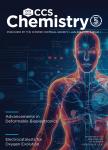Pd(II)and Rh(III)Complexes with Isoquinoline Derivatives Induced Mitochondria-Mediated Apoptotic and Autophagic Cell Death in HepG2 Cells
作者机构:State Key Laboratory for Chemistry and Molecular Engineering of Medicinal ResourcesSchool of Chemistry and PharmacyGuangxi Normal UniversityGuilin 541004 International Center for Chemical and Biological SciencesUniversity of KarachiKarachi 74270
出 版 物:《CCS Chemistry》 (中国化学会会刊(英文))
年 卷 期:2021年第3卷第6期
页 面:1626-1641页
基 金:This work was supported by the National Natural Science Foundation of China(grant no.21431001) IRT_16R15,and Natural Science Foundation of Guangxi Province of China(grant nos.2016GXNSFGA380005 and AD17129007)as well as the“BAGUI Scholar”program of Guangxi Province of China
主 题:palladium(II) rhodium(III) isoquinoline derivatives anticancer apoptosis autophagy
摘 要:Nonplatinummetal complexes of[Pd(L^(1))Cl_(2)](C1),[Rh(L^(1))Cl_(3)(DMSO)](C2),[Pd(L^(2))Cl_(2)](C3),and[Rh(L^(3))Cl_(3)(DMSO)](C4)with isoquinoline derivatives have been prepared and characterized.C1-C4 exhibited higher in vitro anticancer activity and lower toxicity than the corresponding ligands and cisplatin against HepG2 *** mechanistic studies revealed that C1 arrested the cell cycle at S-phase by regulation of cyclin and cyclin-dependent kinases.C1 was accumulated in mitochondria,which increased the generation of reactive oxygen species(ROS)and endoplasmic reticulum(ER)-stress response through mitochondrial ***,C1 stimulated Ca^(2+)release,activated the caspase cascade,and triggered mitochondria-mediated *** in vivo studies of C1 demonstrated higher safety than cisplatin and effective tumor growth inhibition.C1 is a potential anticancer drug candidate.



